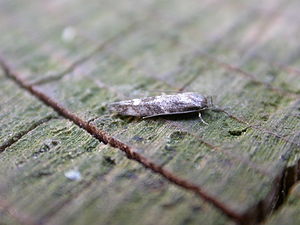Mompha subbistrigella
| Mompha subbistrigella | ||||||||||||
|---|---|---|---|---|---|---|---|---|---|---|---|---|

Mompha subbistrigella |
||||||||||||
| Systematics | ||||||||||||
|
||||||||||||
| Scientific name | ||||||||||||
| Mompha subbistrigella | ||||||||||||
| ( Haworth , 1828) |
Mompha subbistrigella is a butterfly ( moth ) fromthe fringed moth family (Momphidae).
features
The moths reach a wingspan of 7 to 12 millimeters. The head is mottled gray and light gray. The thorax and fore wings are dark gray.
In the males, the cucullus is wide at the base and tapers distally . The saccule is cut off and has three or four short, thick teeth at the apex. The aedeagus has a large cornutus with a hatchet head at the end. Another cornutus is long and a third is short and slightly curved. The shape of the apical part of the saccule and the cornuti are characteristic of the species.
In females, the antevaginal lamella consists of two wedge-shaped sclerites and a small sclerotized plate in between. The ductus bursae is divided into a short and narrow posterior (subostial) part and a long and broad part. The shape of the antevaginal lamella and the ductus bursae are characteristic of the species.
Similar species
M. subbistrigella basically has the same wing markings as Mompha sturnipennella , but the rust-colored lines in the middle of the forewing are missing and there are clear white costal lines in the apical area.
distribution
Mompha subbistrigella is common in northern and central Europe. In the east the distribution area extends to the Caucasus and Central Asia .
biology
The caterpillars develop on smaller willowherb species ( Epilobium ) such as the mountain willowherb ( Epilobium montanum ), the marsh willowherb ( Epilobium palustre ), the clover-flowered willowherb ( Epilobium parviflorum ) and the square willowherb ( Epilobium ). The caterpillars live in the seed capsule and feed on the immature seeds from late June to July. Seed pods infested by caterpillars are shorter, curved and have a small hole in them. Butterflies can be found throughout the year. After overwintering, they can often be seen from late spring to early summer. According to other information, the moths do not seem to winter in Central Europe .
Systematics
The following synonym is known from the literature:
- Tinea subbistrigella Haworth , 1828
swell
Individual evidence
- ↑ a b c d e J. C. Koster, S. Yu. Sinev: Momphidae, Batrachedridae, Stathmopodidae, Agonoxenidae, Cosmopterigidae, Chrysopeleiidae . In: P. Huemer, O. Karsholt, L. Lyneborg (eds.): Microlepidoptera of Europe . 1st edition. tape 5 . Apollo Books, Stenstrup 2003, ISBN 87-88757-66-8 , pp. 36 (English).
- ↑ Karl Traugott Schütze: The biology of the small butterflies with special consideration of their nutrient plants and times of appearance. Handbook of Microlepidoptera. Caterpillar calendar arranged according to the illustrated German Flora by H. Wagner. Frankfurt am Main, publishing house of the International Entomological Association e. V., 1931, p. 144
- ↑ Karl Traugott Schütze: Communications about some small butterflies. In: Stettiner Entomologische Zeitung . Volume 58 (1897), pp. 299-414.
- ^ Mompha subbistrigella in Fauna Europaea. Retrieved on November 17, 2011
Web links
- Ian Kimber: Guide to the moths of Great Britain and Ireland Photos
- Lepiforum e. V. Taxonomy and Photos
